








Designed by Nigel G Wilcox

Everything For The Metal Detectorist - National Flags





Powered By Sispro1
British, Making of the Union Flag
#FF7900
The Making of the Union Flag
St George - England
St George - England
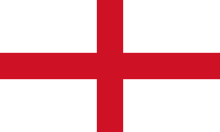
England is represented by the flag of St. George
In 1194 A.D., Richard I of England introduced the Cross of St. George, a red cross on a white ground, as the National Flag of England. At this point in the story on the United Kingdom, England, Scotland, Wales and Ireland were separate countries. However, this was soon to change....
In 1536, under Henry VIII , an Act of Union was passed making Wales, in effect a province of England.
In 1536, under Henry VIII , an Act of Union was passed making Wales, in effect a province of England.
_svg.png)
Scotland is represented by the flag of St. Andrew
(a diagonal white cross form (called a saltire) on a blue field)
(a diagonal white cross form (called a saltire) on a blue field)
After Queen Elizabeth I of England died in 1603, King James VI of Scotland inherited the English throne and became King James I of England. It was a Union of the Crowns, but not yet of the nations. Each country still kept their own parliaments.
Early in his reign James attempted to combine England and Scotland in a united kingdom of 'Great Britain'. This was the policy he presented to his first Parliament, called on 22 March 1604. The union was resisted.
James defied them. On 20 October 1604 he proclaimed a new title for himself as 'King of Great Britain'.
But what flag should be used?
A problem arose, which flag should be hoisted on the king's ships. English sailors resented the Scottish colours and the Scots scorned the cross of St. George
In 1606 the problem was solved ........ A compromise was the answer and it led to the creation of the first Union Flag.
On 12 April 1606, the National Flags of Scotland and England were united for use at sea, thus making the first Union 'Jack'. Ashore however, the old flags of England and Scotland continued to be used by their respective countries.
A royal decree declared that the ships of the Kingdom of Great Britain "shall bear on their maintops the red cross, commonly called St. George's cross, and the white cross, commonly called St. Andrew's cross."
Early in his reign James attempted to combine England and Scotland in a united kingdom of 'Great Britain'. This was the policy he presented to his first Parliament, called on 22 March 1604. The union was resisted.
James defied them. On 20 October 1604 he proclaimed a new title for himself as 'King of Great Britain'.
But what flag should be used?
A problem arose, which flag should be hoisted on the king's ships. English sailors resented the Scottish colours and the Scots scorned the cross of St. George
In 1606 the problem was solved ........ A compromise was the answer and it led to the creation of the first Union Flag.
On 12 April 1606, the National Flags of Scotland and England were united for use at sea, thus making the first Union 'Jack'. Ashore however, the old flags of England and Scotland continued to be used by their respective countries.
A royal decree declared that the ships of the Kingdom of Great Britain "shall bear on their maintops the red cross, commonly called St. George's cross, and the white cross, commonly called St. Andrew's cross."



+

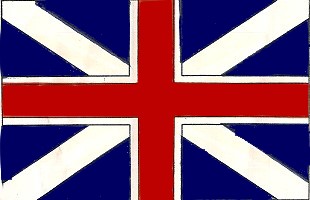
The first Union Flag (1606)
When the red cross of England was put onto the flag of Scotland, a white border was added around the red cross for reasons of heraldry. (The rules of heraldry demanded that two colours must never touch each other.)
On 28th July, 1707, during the reign of Queen Anne, this flag was by royal proclamation made the National flag of Great Britain, for use ashore and afloat.
The Act of Union of 1707, joined England and Scotland together, creating a single kingdom with a single Parliament called 'United Kingdom of Great Britain'.
England Wales and Scotland were now united together under one monarch and one parliament.
The Royal Navy christened the British flag " The Union". When the 'Union Flag' was first introduced, in 1606, it was known simply as 'the British flag' or 'the flag of Britain'.
On 28th July, 1707, during the reign of Queen Anne, this flag was by royal proclamation made the National flag of Great Britain, for use ashore and afloat.
The Act of Union of 1707, joined England and Scotland together, creating a single kingdom with a single Parliament called 'United Kingdom of Great Britain'.
England Wales and Scotland were now united together under one monarch and one parliament.
The Royal Navy christened the British flag " The Union". When the 'Union Flag' was first introduced, in 1606, it was known simply as 'the British flag' or 'the flag of Britain'.
he Making of the Union Flag
St Patrick - Northern Ireland
St Patrick - Northern Ireland
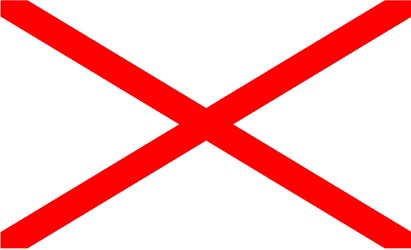
Ireland is represented by the cross of St. Patrick
(A diagonal red cross on a white background
(A diagonal red cross on a white background
On 1 January 1801, Ireland was united with Great Britain and it became necessary to have a new National Flag in which Ireland was represented. The cross St Patrick was combined with the Union Flag of St George and St Andrew, to create the Union Flag that has been flown ever since.


+
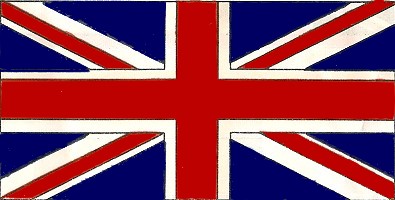
The cross of St. Patrick was inserted so the position given to St. Andrew's Cross in one quarter was the same as that given to the Irish one in the diagonally opposite quarter; in heraldry this is known as "counterchanging"
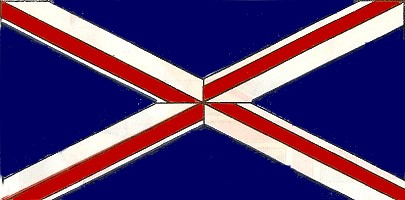
The Union Flag with the St. George's Cross removed showing how the saltires (diagonal crosses) are counterchanged.
The 'new' British flag is not symmetrical because of the counterchange.
As Scotland joined the Union nearly two hundred years before Ireland, St Andrew's Cross was placed uppermost in the top quarter nearest the flagstaff, this being the most honourable position according to heraldry, while the Irish Cross was given the second most honourable position, the top quarter of the fly.
In order to avoid having the red of the Irish Cross directly upon the blue field of the Scottish one an edging of the white field of the Irish Cross is used.
England, Wales, Scotland and Ireland were now all joined together and called the United Kingdom of Great Britain and Ireland. The name was later changed to United Kingdom of Great Britain and Northern Ireland when the greater part of Ireland left the United Kingdom in 1921.
NB. The St. Patrick's Cross remains in the flag even though today only Northern Ireland is part of the United Kingdom.
As Scotland joined the Union nearly two hundred years before Ireland, St Andrew's Cross was placed uppermost in the top quarter nearest the flagstaff, this being the most honourable position according to heraldry, while the Irish Cross was given the second most honourable position, the top quarter of the fly.
In order to avoid having the red of the Irish Cross directly upon the blue field of the Scottish one an edging of the white field of the Irish Cross is used.
England, Wales, Scotland and Ireland were now all joined together and called the United Kingdom of Great Britain and Ireland. The name was later changed to United Kingdom of Great Britain and Northern Ireland when the greater part of Ireland left the United Kingdom in 1921.
NB. The St. Patrick's Cross remains in the flag even though today only Northern Ireland is part of the United Kingdom.
The Union Flag consists of the three heraldic crosses of St George, St Andrew and St Patrick.
The Welsh dragon does not appear on the flag because when the first Union Flag was created in 1606, Wales was already united with England from the 13th century. This meant that Wales a Principality instead of a Kingdom and as such could not be included.
In 1536, under Henry VIII, the Act of Union joined England and Wales officially.
The Union flag with Wales represented (by Ian Lucas)
To deliberately fly the flag upside down is a signal indicating a situation of 'DISTRESS'. It is also "lese Majeste" (which means: insulting the Crown), and is theoretically still a crime in the UK and its commonwealth!
The Welsh dragon does not appear on the flag because when the first Union Flag was created in 1606, Wales was already united with England from the 13th century. This meant that Wales a Principality instead of a Kingdom and as such could not be included.
In 1536, under Henry VIII, the Act of Union joined England and Wales officially.
The Union flag with Wales represented (by Ian Lucas)
To deliberately fly the flag upside down is a signal indicating a situation of 'DISTRESS'. It is also "lese Majeste" (which means: insulting the Crown), and is theoretically still a crime in the UK and its commonwealth!

Courtesy of projectbritain & Wikipedia, (Courtesy of Cdr Bruce Nicolls OBE RN (Retd))
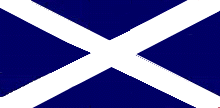
The forming of The Union Flag

When the 'Union Jack' was first introduced in 1606, it was known simply as 'the British flag' or 'the flag of Britain', and was ordered to be flown at the main masthead of all ships, warships and merchant ships, of both England and Scotland.
The first use of the name 'Union' appears in 1625. There are various theories as how it became known as the 'Union Jack', but most of the evidence points to the name being derived from the use of the word 'jack' as a diminutive. This word was in use before 1600 to describe a small flag flown from the small mast mounted on the bowsprit, and by 1627 it appears that a small version of the Union flag was commonly flown in this position. For some years it was called just 'the Jack', or 'Jack flag', or 'the King's Jack', but by 1674, while formally referred to as 'His Majesty's Jack', it was commonly called the Union Jack, and this was officially acknowledged.
In the 18th century the small mast on the bowsprit was replaced by staysails on the stays between the bowsprit and the foremast. By this time the Ensign had become the principal naval distinguishing flag, so it became the practice to fly the Union Jack only in harbour, on a specially rigged staff in the bows of the ships, the jackstaff. It should thus be noted that the jack flag had existed for over a hundred and fifty years before the jack staff came into being, and its name was related to its size rather than to the position in which it was flown.
It is often stated that the Union Flag should only be described as the Union Jack when flown in the bows of a warship, but this is a relatively recent idea. From early in its life the Admiralty itself frequently referred to the flag as the Union Jack, whatever its use, and in 1902 an Admiralty Circular announced that Their Lordships had decided that either name could be used officially. Such use was given Parliamentary approval in 1908 when it was stated that "the Union Jack should be regarded as the National flag".
The first use of the name 'Union' appears in 1625. There are various theories as how it became known as the 'Union Jack', but most of the evidence points to the name being derived from the use of the word 'jack' as a diminutive. This word was in use before 1600 to describe a small flag flown from the small mast mounted on the bowsprit, and by 1627 it appears that a small version of the Union flag was commonly flown in this position. For some years it was called just 'the Jack', or 'Jack flag', or 'the King's Jack', but by 1674, while formally referred to as 'His Majesty's Jack', it was commonly called the Union Jack, and this was officially acknowledged.
In the 18th century the small mast on the bowsprit was replaced by staysails on the stays between the bowsprit and the foremast. By this time the Ensign had become the principal naval distinguishing flag, so it became the practice to fly the Union Jack only in harbour, on a specially rigged staff in the bows of the ships, the jackstaff. It should thus be noted that the jack flag had existed for over a hundred and fifty years before the jack staff came into being, and its name was related to its size rather than to the position in which it was flown.
It is often stated that the Union Flag should only be described as the Union Jack when flown in the bows of a warship, but this is a relatively recent idea. From early in its life the Admiralty itself frequently referred to the flag as the Union Jack, whatever its use, and in 1902 an Admiralty Circular announced that Their Lordships had decided that either name could be used officially. Such use was given Parliamentary approval in 1908 when it was stated that "the Union Jack should be regarded as the National flag".
The Union Jack or The Union Flag?
Scottish-Flag
Flag Menu
English Flag
Copyright All Rights Reserved by Nigel G Wilcox E-Mail: ngwilcox100@gmail.com
The Paragon Of Metal Detecting
& Archaeology
& Archaeology
5. Menu
Pages
Member NCMD























